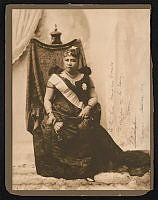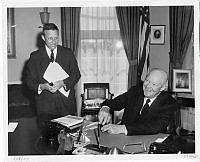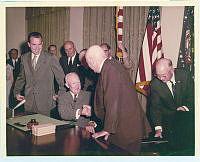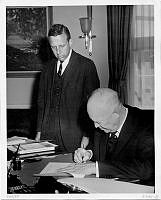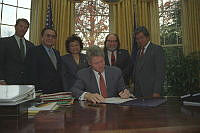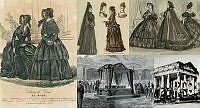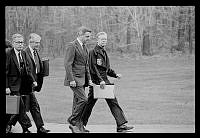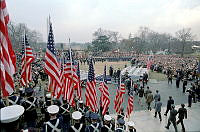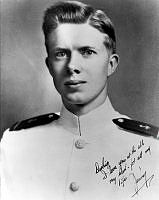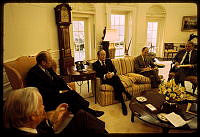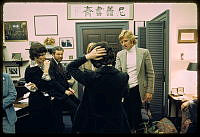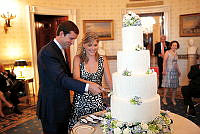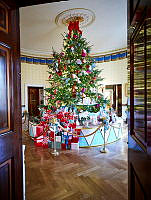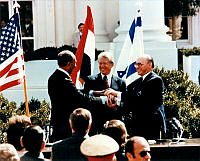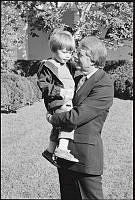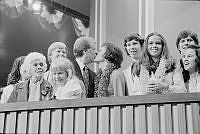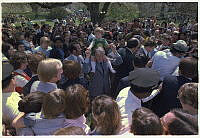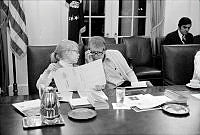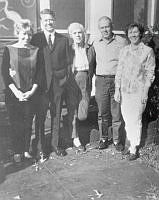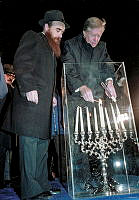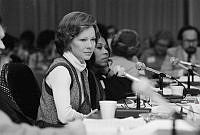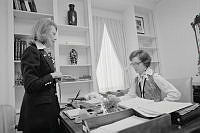Rubenstein Center Scholarship
The Tale of Two White Houses: Espionage during the Civil War
In the nineteenth century, two mansions sitting approximately one hundred miles apart were both called the “White House.” The White House in Washington, D.C., was constructed to serve as the executive seat for the President of the United States. During the War of 1812, British troops burned the building but it was quickly rebuilt and re-occupied by 1817. The following year, a smaller three-story neoclassical style private mansion was constructed in Richmond, Virginia, that would later become the Confederate White House in 1861.1 During the Civil War, both mansions functioned as an office, site for ceremonies, and home for the president and his family.2 These executive mansions represented the competing ideals of the Union and Confederacy and were home to their respective leaders, President Abraham Lincoln and President Jefferson Davis. The success of either side was aided by military intelligence, which was acquired through troop surveys, prisoner interrogations, personal conversations, and reports from secret organizations. Between 1861 and 1865, spies on both sides of the war played important roles in acquiring and transmitting intelligence, and spy craft was not only planned but also carried out at these executive mansions.

Washington, D.C. White House and Confederate White House
White House Collection/White House Historical Association (left), Library of Congress (right)President Abraham Lincoln’s primary source of information was the telegraph office at the War Department. He frequently walked to the War Department, located just west of the White House, where he spent several hours reading incoming telegrams and drafting responses to field commanders. During the summer of 1861, President Lincoln sought the services of William A. Lloyd, who became his personal intelligence operative. Before working for President Lincoln, Lloyd published railroad and steamboat schedules in Southern states, and when the war began, Lloyd was unable to travel to the Confederacy without a passport. Upon reviewing Lloyd’s application, President Lincoln saw an opportunity to employ Lloyd because of his frequent trips to Confederate states. President Lincoln offered to issue a passport and a monthly salary if Lloyd agreed to serve as his personal spy. Lloyd provided many types of information to the president, including maps of Confederate camps and forts, details about supplies in Richmond, and information pertaining to General Robert E. Lee’s forces.3

Lincoln in 1865
Library of CongressAlthough Lloyd’s services were invaluable to President Lincoln, most individuals involved in espionage were unpaid volunteers who relayed information to field commanders, officers, or other officials. For example, Lafayette C. Baker traveled to Washington, D.C. from San Francisco, California, to offer his services to Union General Winfield Scott at the outbreak of the Civil War. On July 11, 1861, under the alias Samuel Munson, Baker embarked on one of his most critical missions. His orders were to gather information about the Black Horse Cavalry at Manassas Junction and learn the location and strength of the Confederate troops in Richmond, Virginia.4 While undercover, he concealed his identity even among Union troops because, according to Baker, “to let the Union troops into the secret, would be to send it to Richmond before I had reached Manassas.”5 Traveling by foot, Baker penetrated Confederate lines at Manassas and shortly afterwards was suspected of being a spy and arrested. Nevertheless, he collected information about the troops and surveyed the two-hundred-person Black Horse Cavalry. As a prisoner, Baker traveled by train to Richmond where he was questioned by Confederate President Jefferson Davis.6

Jefferson Davis between 1855 and 1865
Library of CongressDuring Baker’s imprisonment in Richmond, he visited President Davis at the Spotswood Hotel several times for questioning. Davis lived there from May 30 until August 1, 1861, when he moved into the Confederate White House at 1201 East Clay Street. Throughout the interrogations, Baker revealed only as much information as necessary to placate accusations of espionage and maintain his identity as Samuel Munson. Owing to luck and skill, the Confederates released Baker and he traveled back to Washington, D.C. Upon his return, after an absence of three weeks, Baker reported to General Scott on the number of troops and resources at Manassas and Richmond. Baker intended to use this information to track those he regarded as “northern traitors in their treasonable alliance with the South.”7 On September 12, 1862, Baker was appointed Provost-Marshal of the National Detective Bureau, which later became part of the War Department. He remained in this role until November 7, 1863, investigating charges of disloyalty in the military, supplying information about Confederate troop movements, and orchestrating the capture of the notorious Confederate spy Belle Boyd, who frequently traveled to Union camps from her home in Martinsburg, Virginia.8

LaFayette Curry Baker, 1826-1868, Brig. Gen. and Chief, National Police, head and shoulders, facing left
Library of CongressOn July 4, 1861, Belle shot and killed a Union soldier who, according to her memoir, had accosted her mother. She was not punished for her actions and Union guards were stationed around the Boyd residence to ensure their safety, in the event that someone might try to harm Belle or her mother in retaliation. Belle was in frequent contact with Union officers who were responsible for ensuring her and her mother’s safety. Due to her proximity to these officers, she overheard important information regarding the positions and plans of the Union Army. As she stated in her post-war memoir, “whatever I heard I regularly and carefully committed to paper, and whenever an opportunity offered [itself] I sent my secret d[i]spatch by a trusty messenger to … some brave officer in command of the confederate troops.”9
In addition to transmitting military intelligence to Confederate forces, Belle also confiscated Union weapons and smuggled them into Confederate camps. In October 1861, Belle served as a courier for General Thomas Jonathan “Stonewall” Jackson and on May 23, 1862, rushed to inform General Jackson that several divisions of the Union Army would cooperate to defeat the Confederates in the pending Battle of Fort Royal in Virginia.10 According to Belle, as she hurried across the battlefield, “rifle-balls flew thick and fast about me, and more than one struck the ground so near my feet as to throw the dust in my eyes.”11 After dodging Union and Confederate crossfire to complete her mission, Belle was later recognized for her bravery and contribution to the Confederate victory in the form of a personal letter from General Jackson.12

Belle Boyd
Library of CongressAs Belle’s role as a spy demonstrated, not all espionage during the Civil War involved or resulted in meetings with presidents in executive mansions. Rose O’Neal Greenhow is one example of how spies functioned as intermediaries who passed along information to field commanders. Rose also aided the Confederate cause and, like Belle, was captured by Union officials. She was born around 1814 in Montgomery County, Maryland, and as a teenager, moved to Washington, D.C. On May 26, 1835, Belle married federal librarian, Dr. Robert Greenhow.13 From their residence at 398 16th Street, near the White House, Rose lived in the heart of Washington’s most affluent social circles and made the acquaintance of prominent figures such as First Lady Dolley Madison, President James Buchanan, and Vice President John C. Calhoun. During the Civil War, Rose became a spy for the Confederacy and reported to Colonel Thomas Jordan. Rose passed along information warning the Confederate troops at Manassas about the Union Army’s plans to attack. Her intel contributed to the Confederacy’s success in the First Battle of Manassas (also known as the Battle of Bull Run).14 On July 23, 1861, Rose received a letter from Colonel Jordan stating, “Our President and our General direct me to thank you. We rely upon you for further information. The Confederacy owes you a debt.”15 In 1863, Rose published My Imprisonment and the First Year of Abolition Rule at Washington, which describes her acts of espionage; observations of events at the Lincoln White House including First Lady Mary Lincoln’s February 9, 1862, ball and heightened White House security in case of attack by Confederate forces; and her time under house arrest less than a mile away from the Executive Mansion.16
Gallery
-

Rose O'Neal Greenhow
Library of Congress -

Letter written in cipher on mourning paper by Rose Greenhow
National Archives and Records Administration
Unlike Rose, pro-Union spy Elizabeth Van Lew evaded capture during her missions into Confederate territory. Elizabeth was born in Richmond in 1818.17 In July of 1861, Elizabeth began volunteering as a nurse at Libby Prison where she also supplied provisions for Union prisoners and relayed messages concealed inside book spines.18 Seeking to further contribute to the Union effort, Elizabeth devised a plan involving a formerly enslaved woman, Mary Jane Richards, to infiltrate the Confederate White House.

Elizabeth Van Lew with her nieces, brother John, and servant on main mansion grounds
Elizabeth Van Lew Papers, New York Public LibraryThroughout her lifetime, Mary went by several pseudonyms including Mary Jane Bowser, Mary Elizabeth Bowser, Richmonia Richards, and Mary J. Denman.19 Mary was born sometime between 1839 and 1841, and was enslaved by Elizabeth’s parents, John Van Lew and Eliza Louise Baker Van Lew.20 The Van Lew family manumitted Mary prior to the outbreak of the Civil War.21 During the war, Elizabeth arranged for her to spy in the Confederate White House. At the recommendation of one of Elizabeth’s friends, Mary began by serving at events hosted in the Davis mansion and was eventually hired by First Lady of the Confederacy Varina Howell Davis in 1863.22

Jefferson Davis and family
Library of CongressIn the early 1850s, with the support of the Van Lew family, Mary received an education from an African-American Presbyterian school in Princeton, New Jersey; however, she later pretended to be illiterate so as not to warrant suspicion while serving in the Confederate White House.23 Based on the surviving pages of Elizabeth’s journal, we do not know the exact intelligence Mary was able to procure. According to Union spy recruiter Thomas McNiven, Mary had a photographic memory: “Everything she saw on the Rebel President’s desk she could repeat word for word. Unlike most colored, she could read and write. She made the point of always coming out to my wagon when I made deliveries at the Davis’ home to drop information.”24 Operating from inside the Confederate White House, Mary passed along information she heard and shared Jefferson Davis’ war plans with Elizabeth.25

The cipher Van Lew used to send messages to Union commanders.
Elizabeth Van Lew Papers, New York Public LibraryIn addition to Mary Jane Richards, several free and enslaved African Americans were involved in Elizabeth Van Lew’s twelve-person network of White and Black spies.26 Writing in her journal, Elizabeth expressed appreciation for the services of the African Americans involved in her spy ring, whose contributions helped the Union achieve victory. In an entry dated May 14, 1864, Elizabeth wrote: “Most generally our reliable news is gathered from negroes, and they certainly show wisdom, discretion and prudence, which is wonderful.”27 African Americans were able to infiltrate private residences because they were constantly present to serve their enslavers. Additionally, because of their status and societal perceptions of racial inferiority, they were overlooked, ignored, and underestimated.
There were several enslaved African Americans living at the Confederate White House during Mary’s period of espionage. The Davis family enslaved two of these individuals at their Mississippi Brierfield plantation and brought them to the Richmond White House.28 Additionally, William A. Jackson was an enslaved man whose enslaver, G. W. Tyrer, hired him out as President Davis’ coachman in the summer of 1861. Jackson managed to escape, and although he was not necessarily a spy, he did provide Union Major General Irvin McDowell some insights about Davis’ general morale and personal struggles over the war effort, as well as details about the Confederate fortifications in Richmond.29 According to Rose Greenhow, Jackson “had frequent interviews” with President Lincoln at the White House. During their conversations, which Jackson reported to local press, Jackson provided information about the evacuation of Richmond during the Union Army’s advance and shared that President Davis had devised a tunnel system to facilitate his safe escape.30

William A. Jackson, ex-coachman of Jeff Davis
Library of CongressIn December 1863, Elizabeth Van Lew began working directly with Union Major General Benjamin F. Butler to help Union prisoners escape from Libby Prison. Elizabeth aided the Union war effort by helping with escape plans for Union prisoners, and even agreed to house and assist those who escaped on their way back to the North. Elizabeth also played a major role in facilitating the proper burial of Union Colonel Ulrich Dahlgren following a failed raid of Libby Prison.31 Elizabeth also sent information to Generals George H. Sharpe, Benjamin F. Butler, George G. Meade, and Ulysses S. Grant, as chief correspondent of the Union spy network, thus contributing to the success of the Union assault by Grant’s army on Richmond.32 After the Civil War, once Grant became president, he repaid Elizabeth for her contributions to the Union victory by submitting her name to the Senate for the position of postmistress in Richmond where she served from 1869 until 1873.33
On April 3, 1865, Union forces under the command of General Ulysses S. Grant captured the Richmond White House, causing the Confederate government to flee. The next day, President Lincoln traveled by boat and horseback to visit the former home of Confederate President Jefferson Davis. According to a Richmond Whig newspaper article, a crowd “surrounded the mansion, and sent up cheer after cheer as the President entered the doorway” to the entrance hall. As Lincoln toured the first floor, passing through the adjoined rooms, he was likely reminded of the floor plan in the Washington, D.C. White House. Lincoln reached the state dining room, and “seated himself in the reception room and reception chair of Jefferson Davis.”34 From the state dining room, Lincoln moved to the center parlor where he proceeded to interview representatives of the former Confederate government, who sought an audience with him to discuss the treatment of ex-Confederates.35 Following the capture of Richmond, President Lincoln returned to Washington, D.C. where he delivered his final public speech about Reconstruction from the window above the North Door at the White House on April 11, 1865, approximately one month prior to the official end of the Civil War on May 13, 1865.36

Lincoln in Richmond
National Portrait Gallery, Smithsonian Institution; Alan and Lois Fern Acquisition FundThat same day, spy Lafayette C. Baker noted the “extraordinary indifference in the mind of Mr. Lincoln in regard to threats of assassination, some of which I communicated to him.” Baker spoke with the president on multiple occasions on the White House Grounds concerning the matter. According to Baker, “he almost playfully listened, and apparently was unable to believe depravity could go so far as to destroy a friend of all the people, such as he felt himself to be.”37 On April 14, 1865, John Wilkes Booth shot President Lincoln, who died the following morning. Although Baker’s fear, and that of thousands of others, was soon realized, the information he had gathered pertaining to attempts on the president’s life indicate that espionage was a key aspect of the Civil War, even until President Lincoln’s assassination.
During the Civil War, espionage was critical to the unfolding of events of political and military significance. In Richmond and Washington, D.C., the executive mansions became sites for the battle over intelligence. Union and Confederate spies were drawn to the homes of Lincoln and Davis in search of information that would aid their respective sides of the war. These battles for intelligence were often crucial to success on the battlefield. Spies worked constantly to evade capture and went to great lengths to encrypt information and secure its transmission. As a result, the most famous spies were celebrated as heroes or regarded as enemy agents. William A. Lloyd and Lafayette C. Baker contributed to the Union cause through their close relationships with President Lincoln and their ability to convey intel to other leading officials. Confederate spies Belle Boyd of Martinsburg and Rose O’Neal Greenhow of Washington, D.C. supplied important information to Confederate officials. Elizabeth Van Lew operated out of Richmond in support of the Union alongside Mary Jane Richards, who infiltrated the Confederate White House. Collectively, these skilled spies contributed to the outcome of the Civil War.
About the Author
Tianna joined the Association as a student fellow in September 2020 while pursuing her M.A. in Global and Comparative History at Georgetown University. As a fellow, she primarily assists with the Slavery in the President’s Neighborhood initiative. She has previously worked on a collaborative digital history project between the Organization of American Historians and the National Parks Service, titled “Escaping Slavery, Building Diverse Communities.” She is a native of Florida and holds a B.A in History from Georgetown University.













